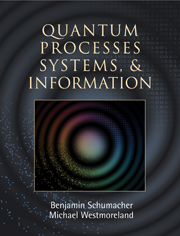
-
Select format
-
- Publisher:
- Cambridge University Press
- Publication date:
- June 2012
- March 2010
- ISBN:
- 9780511814006
- 9780521875349
- Dimensions:
- (246 x 189 mm)
- Weight & Pages:
- 1.21kg, 482 Pages
- Dimensions:
- Weight & Pages:
You may already have access via personal or institutional login
Book description
A new and exciting approach to the basics of quantum theory, this undergraduate textbook contains extensive discussions of conceptual puzzles and over 800 exercises and problems. Beginning with three elementary 'qubit' systems, the book develops the formalism of quantum theory, addresses questions of measurement and distinguishability, and explores the dynamics of quantum systems. In addition to the standard topics covered in other textbooks, it also covers communication and measurement, quantum entanglement, entropy and thermodynamics, and quantum information processing. This textbook gives a broad view of quantum theory by emphasizing dynamical evolution, and exploring conceptual and foundational issues. It focuses on contemporary topics, including measurement, time evolution, open systems, quantum entanglement, and the role of information.
Reviews
'This is a fantastic book, with one of the authors no less than the very inventor of the word and idea of a qubit. When I opened the book for the first time, I found I couldn't stop reading through it and working out some of the problems. … There's no book out there I would recommend more for learning the mechanics of this quantum world.'
Chris Fuchs - Perimeter Institute for Theoretical Physics
'One of the most original and insightful introductions to quantum mechanics ever written, this book is also an excellent introduction to the emerging field of quantum information science.'
Michael Nielsen - co-author of Quantum Computation and Quantum Information
'This superb new book by Ben Schumacher and Mike Westmoreland is perfectly suited for a modern undergraduate course on quantum mechanics that emphasizes fundamental notions from quantum information science, such as entanglement, Bell’s theorem, quantum teleportation, quantum cryptography, and quantum error correction. The authors, who are themselves important contributors to the subject, have complete mastery of the material, and they write clearly and engagingly.'
John Preskill - California Institute of Technology
'This is a wonderful book! It covers the usual topics of a first course in quantum mechanics and much more, and it does so with an unusual conceptual depth. The inclusion of information theoretic ideas not only enriches the presentation of the basic theory - for example in helping to articulate the conditions under which quantum coherence is lost - it also opens up the large area of physics in which both quantum mechanical and information theoretic concepts play central roles.'
William K. Wootters - Williams College
'With its comprehensive presentation of both quantum mechanics and QIC, this book, written by two pioneers of this emerging new approach to computing, is really one of a kind … Most concepts that one would find in traditional nonrelativistic quantum mechanics physics books are presented in a clear and well thought-out manner (but be prepared for a bit more work when dealing with subtle notions such as quantum relative entropy or mutual information) … The brilliant pedagogical approach taken by the authors, who are able to present quite abstract notions using a clear and sprightly style, together with the quality of the editing … will provide both students and researchers interested in the growing field of QIC with a pleasant and informative read.'
Source: Computing Reviews
'… a very impressive piece of work. It has clearly been refined over some time; the explanations and proofs that are scattered throughout the text are clearly written and elegant, and common themes are picked up repeatedly with increasing sophistication as the book goes along …'
Source: Mathematical Reviews
'A bright undergraduate would get a tremendous grounding in modern quantum theory from reading this book, and solving the problems therein. So would many postgraduate students and academics wanting to get into the heart of quantum information research.'
Howard M. Wiseman Source: Quantum Information Processing
‘The book is very well organized and the topics are introduced in an easy to follow way, good for students and instructors.’
Mazin Khasawneh Source: Shenandoah University
Contents
Metrics
Altmetric attention score
Full text views
Full text views help Loading metrics...
Loading metrics...
* Views captured on Cambridge Core between #date#. This data will be updated every 24 hours.
Usage data cannot currently be displayed.
Accessibility standard: Unknown
Why this information is here
This section outlines the accessibility features of this content - including support for screen readers, full keyboard navigation and high-contrast display options. This may not be relevant for you.
Accessibility Information
Accessibility compliance for the PDF of this book is currently unknown and may be updated in the future.


